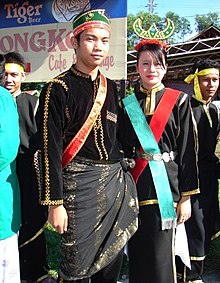|
Bisaya (Borneo)
Bisaya is an indigenous people from the northwest coast of East Malaysia on the island of Borneo. Their population is concentrated around Beaufort as well as Kuala Penyu districts of southern Sabah (in which they are counted under the Kadazan-Dusun group of peoples), Labuan Federal Territory and in Limbang District, Sarawak (in which they are grouped under the Orang Ulu designation). The Bisaya tribe has many similarities with the Dusun Tatana tribe, especially in terms of language. It is evident that some of their dialogical language conversations are almost identical if they have a dialogue with each other. Nowadays the Bisaya living in Sabah are Muslims, while the Bisaya living in Sarawak are mostly Christians. In Brunei, they are referred as Dusun, Jati Dusun and Bisaya (one group with the Dusun people of Sabah, Dusunic people).[5] The Bisaya is closely related, linguistically, with the Tatana Dusun of Kuala Penyu, Sabah. Origin and etymologySeveral theories have been put forward by various researchers regarding the origins of the name of the Bisaya people. Beyer H.O. in 1926, Hester E.D. in 1954 and Harrison in 1956 suggested that the name may have come from the empire of Sri Vijaya (Sonza, 1972). However, in 1960, Eugene Vestraelen (Professor of Linguistics at the University of San Carlos, Cebu City) cautioned that the linguistic derivation of Vijaya would not be Bisaya but Bidaya, or Biraya.[6] Another theory was suggested by John Carroll:[7]
History The proto-Bisaya's indigenous people settled in Borneo thousands of years ago. They are skilled in agriculture, particularly in the areas such as paddy planting, ginger, sago, local ginger, tapioca, banana, yam, pepper, coconut. They also hunt animals and breed others, such as chicken, duck, goose, goat, buffalo, cows and many more. Bisaya people are skilled in catching fish either from the river or at sea, and they can hold their breath under water without drowning. LanguageSabah Bisaya language has 90% intelligibility of Tatana, a Dusun dialect. Bisaya in Sabah also has 58% lexical similarity with dialects of Sarawak Bisaya and 57%–59% with Brunei dialect.[8] Bornean Bisaya belong to the Dusunic group, linguistically. Music, arts and craftsThe traditional musical instrument consists of Kulintangan, gong, and many of small gongs (cf. Asmahs claim that the Bisaya are supposed to be the best gong musicians). It is as if somebody just beats the gong and everyone-men, women, young and old just starts to dance. All these instruments are used in the wedding ceremony, celebrating very important people etc. Besides the musical items, the Bisayas are able to make good weapons for various purposes. There are andiban, sumpit, parang, keris and knife. Culture and traditionBelief and customsThe majority of the Bisaya in Sabah (Beaufort) are Muslims while the Bisaya in Sarawak (Limbang & Miri) are mostly Christians. Though they treasure their cultural traditions of medicine, marriages, death etc., they don't actually practice it, possibly due to the influence of the religions. Even though they would call the traditional medicine men or women known as Bobolian to perform rites in times of illness, most now go to modern medical clinics. Folk dance
Folk songs
Folk games
Traditional attireWhite shirt, Songket, Tarbus, smoking pipe, Keris, bracelet Traditional desserts
FestivalsRumbiaThe leaves (roun rombia)The Rumbia's leaves can be woven into a product called Kajang. This product is used for roofing and walling material when building a house or farm hut. Young girls are trained by the older women. The woven Rumbia's leaves need to be dried under the sun. These leaves last for two to three years. The branchIn the past, the branches of the Rumbia tree were used as walls for a house or hut. The branch can be used to build chicken coops and fences, and the dried branches can be used as a torch. The skin of the branch can be woven into basket, mat, and others. The trunkThe upper portion of the Rumbia is an edible vegetable that can be eaten raw. This serves as the main vegetable during wedding receptions among the Bisaya community. Then, sago is extracted from the Rumbia's trunk. The skin of the Rumbia tree can be used a firewood, floor for hut, or walls. The trunk can be used as a bridge and can also be made into a boat. Water can be extracted from the roots. MibulangOne of their main festivals called Babulang or Mibulang such as buffalo racing is celebrated annually in Batu Danau, Limbang, Sarawak near the Brunei border, and it occurs in the month of June annually once Gawai Dayak occurs simultaneously during that festival. Notable people
See also
References
Further reading
|
||||||||||||||||||||||||
